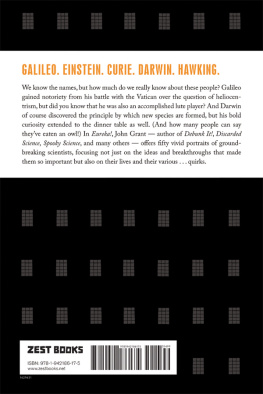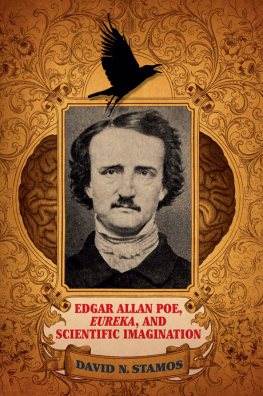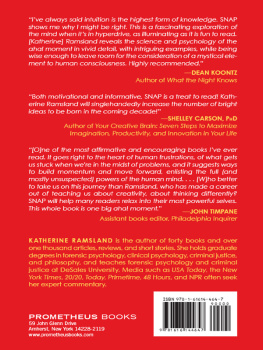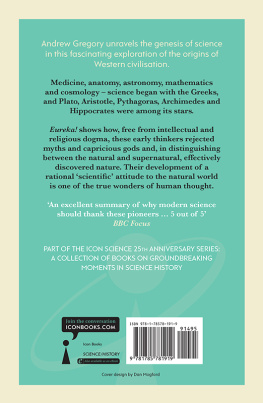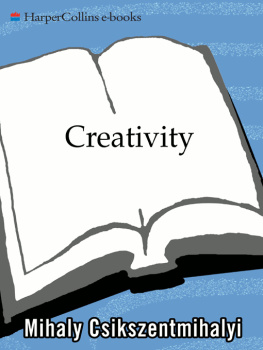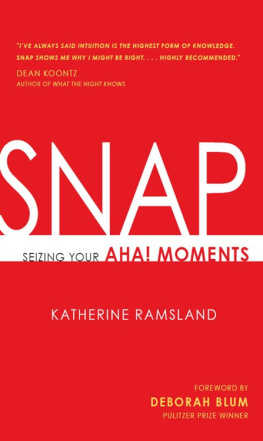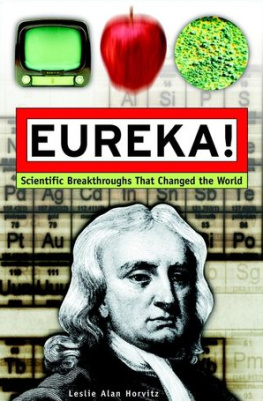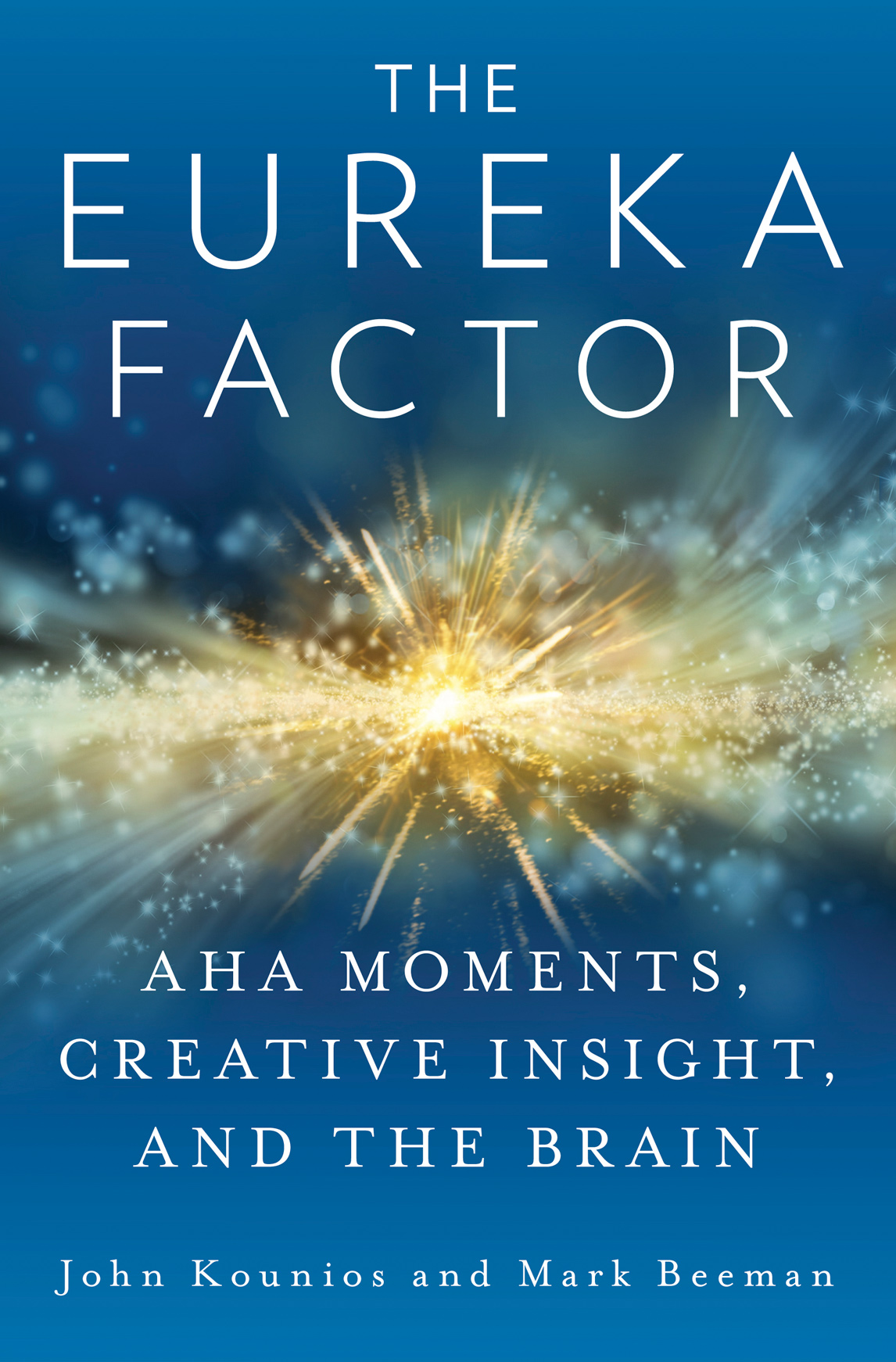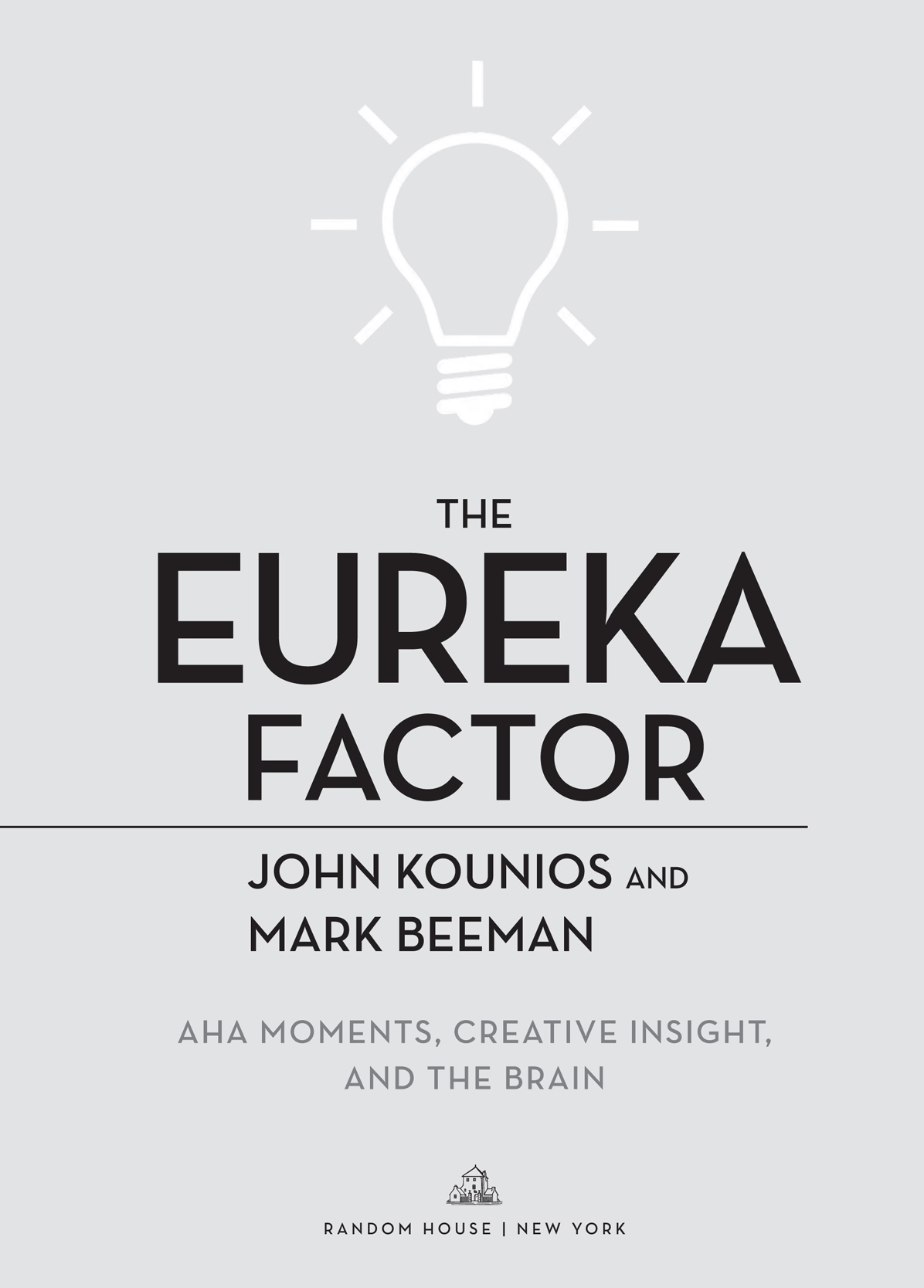Copyright 2015 by John Kounios and Mark Beeman
All rights reserved.
Published in the United States by Random House, an imprint and division of Penguin Random House LLC, New York.
R ANDOM H OUSE and the H OUSE colophon are registered trademarks of Penguin Random House LLC.
L IBRARY OF C ONGRESS C ATALOGING - IN -P UBLICATION D ATA
Kounios, John.
The eureka factor: aha moments, creative insight, and the brain /
John Kounios and Mark Beeman.
pages cm
Includes index.
ISBN 978-1-4000-6854-8
eBook ISBN 978-0-679-64529-0
1. Insight. 2. Intuition. 3. Thought and thinkingPhysiological aspects.
4. Higher nervous activityMeasurement.
5. CognitionPhysiological aspects. I. Beeman, Mark. II. Title.
QP395.K65 2015
612.82332dc23
2014022220
www.atrandom.com
Illustrations on are by Sharon OBrien,
and illustrations on are by Casey Hampton.
Book design by Casey Hampton
v3.1_r1
PREFACE
Eureka! No one knows for sure whether Archimedes really shouted this word, jumped from his bathtub, and ran through the streets of ancient Syracuse proclaiming his latest discovery. But the story has persisted for two millennia because it resonates with peopleyou have probably had such aha moments or sudden realizations yourself. These insights, as psychologists call them, are powerful experiences that expand our understanding of the world and ourselves. They can confer both enlightenment and practical advantage.
Stories of insight resonate with us, as well, which is why weve been studying these moments for almost twenty years. Its why we wrote this book. Our goal is to explain what insights are, how they arise, and what the scientific research says about how to have more of them. But first we would like to tell you a bit of the history of our work and, more generally, of research on insight.
During the decades following World War I, German psychologists documented that when faced with a confusing and seemingly intractable problem, a person may suddenly realize that he or she had been thinking about it in the wrong way and that the solution is actu ally quite straightforward. Solving a problem is all about how you see it.
After identifying insight, psychologists focused on characterizing it. In particular, they sought to show that it is unique and different from deliberate, conscious thoughtwhat they call analysis. For example, in the 1980s, psychologist Janet Metcalfe showed that people can consciously monitor their deliberate analytic thought; however, the mental processes leading up to an insight are largely unconscious, making it difficult to monitor them and predict when a solution will burst into awareness as an aha moment. Another advance occurred in the early 1990s when another psychologist, Jonathan Schooler, demonstrated that insightful thought is fragile and easily overshadowedthinking out loud makes it less likely that you will solve a problem with a flash of insight, but talking your way through a problem wont impair your ability to solve it analytically.
Despite Schoolers discovery, by the 1990s new research findings about insight were rare. The field had become almost dormant. Though insight remained a core topic of experimental psychology covered in nearly every introductory psychology textbook, no one had been able to pin down its mechanics. The most important questions remained: How do insights occur? Can we spur more of them?
There was an obstacle to progress, one that has to do with insights very essence: It feels different. The potency of aha moments is why people notice and remember them. Nevertheless, some skeptics maintained that this feeling is misleading and that insights differ from deliberate thought only in how people feel when they reach a solution. Otherwise, they are nothing special. Eurekas as true creative breakthroughs, they argued, are fairy tales.
When we met while working at the University of Pennsylvania in late 2000, we discussed whether the skeptics could be right. What if aha moments feel different but arent otherwise unique? Perhaps they are just ordinary thought that occasionally yields extraordinary results. If only there were some objective marker to validate the subjective experience of insightsomething that would help us to isolate aha moments and analyze them to figure out whether they are distinct.
We realized that this kind of objective marker of insight does potentially existin the activity of the brain. That set us on our path.
Until then, Marks research had focused on a different topic: how language comprehension relies on the brains right hemispherethe side of the brain noted more for spatial processing than for language. Based on others research and his own studies of subtle language deficits in patients with damaged right hemispheres, he proposed a theory of how the hemispheres process information differently from each other. A turning point in Marks career occurred in 1994 when he heard Jonathan Schooler lecture about insight. This convinced him that the same characteristic of the right hemisphere that enables people to flexibly comprehend languagenamely, the ability to draw together distantly related informationalso contributes to aha moments. During the 1990s, Mark teamed up with Edward Bowden, an insight researcher he knew from their graduate school days, to collaborate on behavioral studies that provided support for the special role of the right hemisphere in insight. Meanwhile, Mark began investigating language with fMRIfunctional magnetic resonance imagingto map out the brain areas that enable people to comprehend stories. Soon, he began to think about using fMRI to study insight.
In the 1990s, Johns main research interest was the neural basis of semantic memoryhow people acquire, use, and sometimes lose their knowledge. He recorded the brains electrical activity with EEGelectroencephalographyto trace out, moment by moment, how one brings a concept to mind. Looking at how insights spring to mind was the next logical step. He and Roderick Smith, his doctoral student, published a behavioral study showing that insights arise abruptly and in their entirety, validating the conscious experience of suddenness. This started him thinking about using EEG to study insight.
The field of brain imaging started to take off in the early 1990s and developed rapidly throughout that decade. The availability of these techniques meant that we werent limited to observing the outward behavior of people. We could peer inside their working brains. That changed everything.
Early neuroimagers mostly investigated abilities that had already been extensively explored by psychological scientists, such as perception, attention, movement, and memory. They shied away from the more difficult task of investigating mental abilities that were more complex and less well understood, such as reasoning, decision making, and problem solvingnever mind insight.
We believed that we were ready to use these tools to study insight, but we had a scientific decision to make: Which experiment should we run? Research funds and time were scarce. Each of us had just enough funding to support one experiment. But which experiment should we do? We circled around this question for a while but kept coming back to the one issue that proved to be the key: What happens in the brain at the instant when a person solves a problem with a flash of insight? We designed an experiment that would illuminate the aha moment itself.


